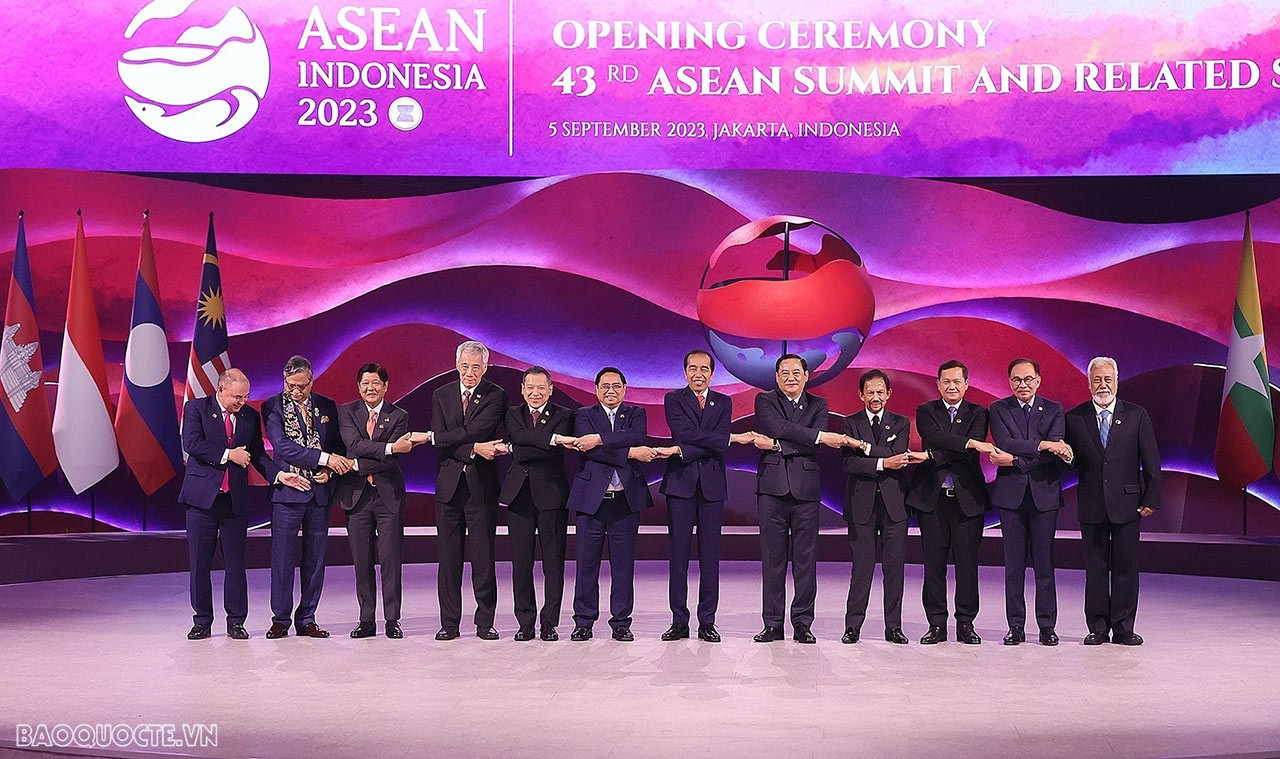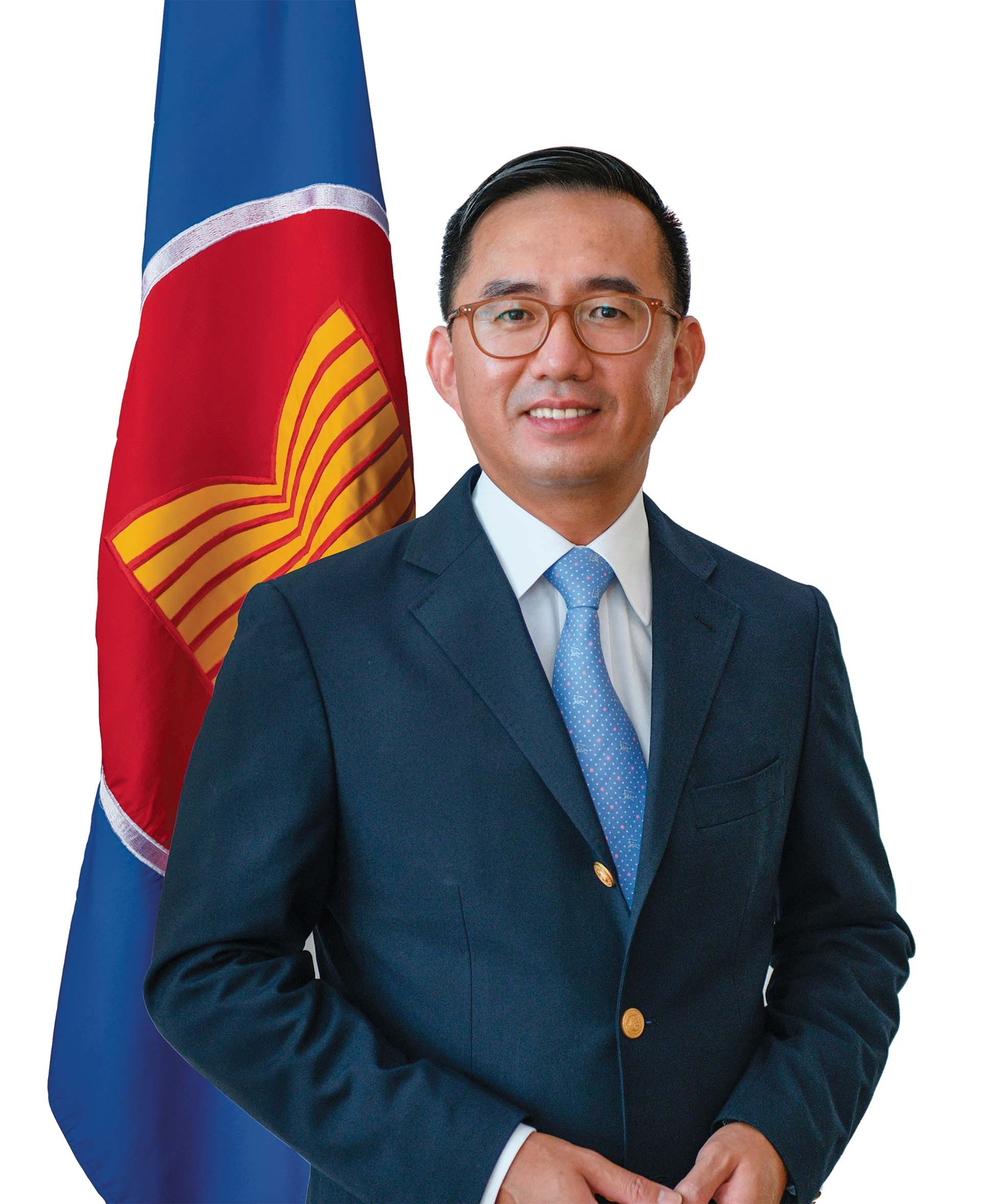
ASEAN - An indispensable factor for peace and prosperity
Latest
 |
| Prime Minister Pham Minh Chinh and Heads of delegations from ASEAN countries attended the Opening Ceremony and Plenary Session of the ASEAN-43 Summit in Jakarta, Indonesia on September 5, 2023. (Photo: Anh Son) |
When referring to ASEAN 2023, we can refer to the word “Epicentrum” – the epicentrum of development, peace and cooperation. Could you comment on the roles and contributions of ASEAN in addressing challenges over the past time?
Indonesia has chosen “ASEAN Matters: Epicentrum of Growth” as the theme for 2023, reflecting ASEAN’s strategic goals and vision for the years to come. The theme also affirms ASEAN Centrality and sets up the stage for ASEAN to rise up to the challenges amidst the evolving and fluid geopolitical, geo-economic, and socio-cultural transformations.
In fact, ASEAN has persevered and prospered over the past five and a half decades to become an indispensable player and major contributor to peace and prosperity in Southeast Asia and beyond. ASEAN today is widely recognised as a successful model of regionalism.
The most important success of ASEAN, no doubt, is the maintenance of peace and stability in Southeast Asia. ASEAN has actively advocated a rules-based regional architecture in which all countries, large or small, co-exist with respect for national independence, sovereignty and territorial integrity on an equal footing, within a set of rules and norms anchored in international law. The Treaty of Amity and Cooperation in Southeast Asia (TAC), the very first ASEAN treaty, is widely recognised as the code of conduct for inter-state relations in Southeast Asia. Its purposes and principles have been gradually universalised with 41 non-ASEAN High Contracting Parties now in its fold, including all major powers.
With efforts in confidence building and norms setting, and through regular exchanges among regional leaders and officials, ASEAN processes, which based on mutual consultation and consensus, have ensured that animosity gradually gives way to cooperation and unity, enabling ASEAN to make steady and stable progress in our community building efforts, including in times of challenges.
And there are other notable successes…?
 |
| Deputy Secretary-General of ASEAN for Community and Corporate Affairs Tran Duc Binh. (Photo: ASEAN Secretariat) |
Moreover, ASEAN-led mechanisms such as the ASEAN Regional Forum (ARF), ASEAN Plus Three, the East Asia Summit and the ADMM Plus, each having its own strategic significance and historical context, provide much needed platforms for major powers and regional countries to engage in dialogue and cooperation on issues of common interest and concern ranging from non-proliferation to maritime security, from disaster relief and humanitarian assistance to disputes in the South China Sea, among others.
Through these mechanisms, ASEAN has been exercising its centrality to maintain strategic equilibrium in the region, maximize its leverage and space in dealing with the major powers whose interests and priorities do not always coincide with each other and with those of ASEAN, and contribute to building a regional rules-based order.
On the economic front, ASEAN’s pursuit of regional economic integration has been a cornerstone of its progress towards becoming an epicentrum of growth for the global economy. By bringing down trade barriers, promoting market liberalisation, and facilitating the free flow of goods, services, and investments among member states, ASEAN has created a dynamic, competitive and seamless economic landscape, resulting in a combined GDP of USD 3.6 trillion, accounting for approximately 3.6% of the world’s total GDP. Most recently, the entry into force of the RCEP agreement has opened up new opportunities to further enhance and deepen economic cooperation and facilitate market access while reinforcing ASEAN’s position as a major player in global trading system.
Thanks to regional integration, ASEAN’s economic performance over the past few years has been remarkable. And underpinned by solid domestic demands, the regional economy is poised to sustain a positive growth trend projected at 4.6% in 2023 and 4.9% in 2024. In fact, in recently years ASEAN has registered a higher growth rate than the rest of the global economy, reflecting the region’s resilience and adaptability in navigating economic uncertainties.
Indeed, ASEAN’s role in handling emerging challenges and its enhanced importance has showcased the relevance of ASEAN’s existence and its central role in the regional architecture. It also bears reminding that substantive progress in the economic cooperation and enduring people-to-people ties has been due, in large part, to the strong and stable political foundations that ASEAN has been able to preserve.
How do you evaluate Vietnam’s initiatives and recent contributions in ASEAN?
Since joining ASEAN in 1995, Viet Nam has been an active participant and contributor to the regional integration journey and community-building. During Viet Nam’s ASEAN Chairmanship in 1998, 2010, and 2020, Ha Noi displayed able and decisive leadership in steering the region towards undertaking important priorities. Indeed, Viet Nam’s leadership proved critical to ASEAN’s collective efforts to address the COVID-19 pandemic recently.
Following the adoption of the Ha Noi Declaration on the ASEAN Community’s Post-2025 Vision by the ASEAN Leaders in 2020, a High-Level Task on ASEAN Community’s Vision Post-2025 (HLTF-ACV) was formed and submitted a set of core elements for the post-2025 vision for endorsement by the 42nd ASEAN Summit in May 2023. It is envisioned that ASEAN would continue to be responsive and adaptive with strengthened capacity and institutional effectiveness, to enable ASEAN to address crises and emergency situations in a timely manner.
Over the years, Viet Nam has also championed women’s participation in policymaking, politics and security and continues to be a strong advocate of sub-regional development to complement ASEAN’s region wide community-building efforts. Viet Nam has also helped to raise ASEAN’s international profile and coordinated with partners to address many challenges including climate change through various frameworks. Most recently in 2023, the ASEAN-Australia High-Level Dialogue on Climate Change and Energy Transition was convened in Viet Nam, where ASEAN and partners worked out practical actions and cooperation towards energy transition and promoting regional resilience and adaptation to increasing climate change impacts.
Thank you, Ambassador!













